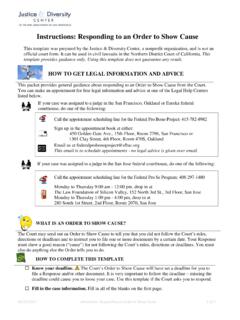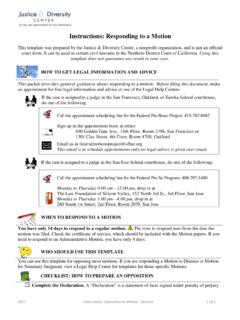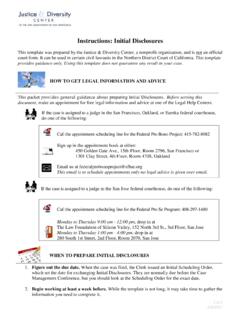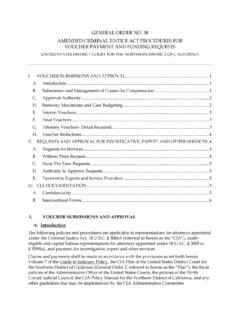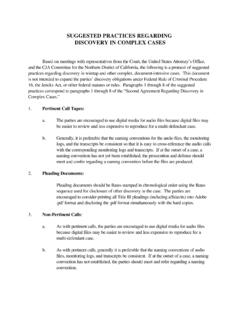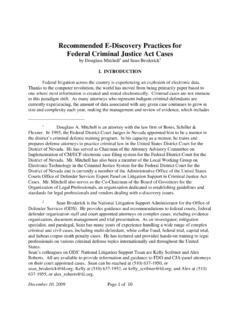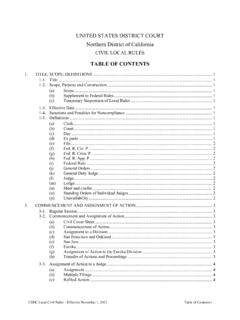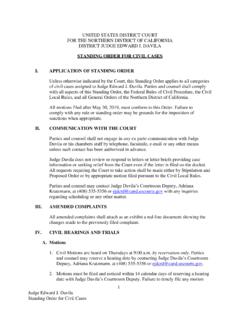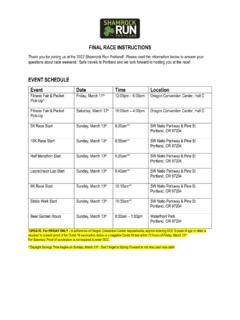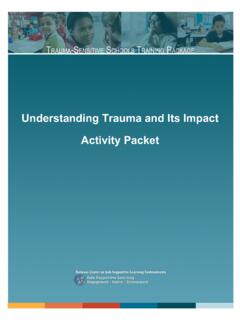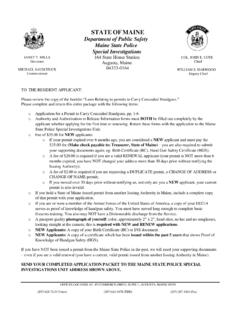Transcription of Instructions: Preparing the Case Management Statement
1 instructions : Preparing the case Management Statement This template was prepared by the Justice & Diversity Center, a nonprofit organization, and is not an official court form. It can be used in certain civil lawsuits in the Northern District Court of California. This template provides guidance only. Using this template does not guarantee any result in your case . HOW TO GET LEGAL INFORMATION AND ADVICE. This packet provides general guidance about Preparing a case Management Statement . Before filing this document, make an appointment for free legal information and advice at one of the Legal Help Centers. If the case is assigned to a judge in the San Francisco, Oakland, or Eureka federal courthouse, do one of the following: Call the appointment scheduling line for the Federal Pro Bono Project: 415-782-8982. Sign up in the appointment book at either: 450 Golden Gate Ave.
2 , 15th Floor, Room 2796, San Francisco or 1301 Clay Street, 4th Floor, Room 470S, Oakland Email us at This email is to schedule appointments only-no legal advice is given over email. If the case is assigned to a judge in the San Jose federal courthouse, do one of the following: Call the appointment scheduling line for the Federal Pro Se Program: 408-297-1480. Monday to Thursday 9:00 am - 12:00 pm, drop in at The Law Foundation of Silicon Valley, 152 North 3rd St., 3rd Floor, San Jose Monday to Thursday 1:00 pm - 4:00 pm, drop in at 280 South 1st Street, 2nd Floor, Room 2070, San Jose WHEN TO PREPARE A case Management Statement . 1. Figure out the date the Statement is due. When the case was filed, the Clerk issued a document called an Initial Scheduling Order, which set the date that this Statement is due. Check this Order and any other Orders issued by the Court to confirm this date.
3 2. Begin working a few weeks before the due date. While the Statement should not take long to prepare, it may take time to reach the opposing side by phone before you file (see the next section). HOW TO COMPLETE THIS case Management Statement TEMPLATE. Contact the opposing side. Before you file a case Management Statement , you must contact the opposing party's lawyer (or the unrepresented party) to talk about the Statement . It is a good idea at this time to ask the other side if they want to submit the Statement together, which the Court prefers. Fill in the case information. Fill in all blanks, including the Conference date and time. Complete Section 1. This section, Jurisdiction, explains why this is the correct court to decide this case , instead of a state court. Federal courts like this one generally decide two types of cases: (1). those involving a violation of federal law ( federal question ); and (2) those involving parties from different states ( diversity of citizenship ), where the plaintiff is suing for more than $75,000.
4 Complete Section 2. This section explains whether the Defendants have been properly served with the Complaint. Review the Proof of Service for each Defendant and write in the correct name and date in the first two columns. If you are not sure about personal jurisdiction or venue, contact the Legal Help Center. Complete Section 3. This should be a short description of what this case is about. Include only the most important facts from the Complaint, including those you and the other side disagree on. Complete Section 4. Briefly explain the laws the Plaintiff says the Defendant violated. If you know of any similar cases that might help you win, you can list those here. Complete Section 5. Motions are requests to the Court, usually made in writing. This section tells the Court which Motions have been filed, and which ones may be filed later. Complete Section 6. If a Plaintiff wants to change its claims, or a Defendant wants to change its defenses or claims, it will need to amend its Complaint or Answer/Counterclaim.
5 If you think you may want to file an amendment, make an appointment at the Legal Help Center (page 1). Complete Section 7. This section, Evidence Preservation, lets the Court know that you are keeping all of the papers, electronic information, such as emails and text messages, and any other records that might be needed by either side. You are required to speak with the opposing side about the type of information each of you is preserving. You are also required to review the Court's Guidelines for the Discovery of Electronically Stored Information, available here: Complete Section 8. At the beginning of almost every case , without the Court telling you to, each party must write its own list of the people and documents that have information supporting its case . This is called Initial Disclosures and parties are required to exchange these. The Legal Help Center has an Initial Disclosure template you can use.
6 Complete Section 9. Discovery is the process used by the parties to collect evidence, information, and testimony from each other. This process includes requests for documents and written questions, as well as depositions and subpoenas. Section 9 describes each side's plan for discovery, and whether there will be problems getting access to the information needed. 2. Review Section 10. Most cases involving pro se litigants are not Class Actions. If you think the case might be a class action, contact the Legal Help Center. Otherwise, there is nothing you need to do in this section. Complete Section 11. The Court wants to know if another judge or other person has been asked to decide a case that is related to this one because it involves some or all of the same people, and the same claims or legal issues. If you are not sure, Local Rule 3-12 (see page 7) gives more information about what kind of cases are related or contact the Legal Help Center.
7 Complete Section 12. State what the plaintiff wants from the defendant, or what the plaintiff wants the Court to do, including any amount of money sought and how that amount was calculated. If a defendant filed a claim, state the same information for the defendant. Complete Section 13. Alternative Dispute Resolution ( ADR ) refers the ways in which cases can be resolved without a trial. The Court wants to know if you have tried to resolve the case informally already. The Court also wants to know which ADR option you choose. If there is information you need or a request you would like the Court to decide in order to make settlement possible, list that below. Complete Section 14. A Magistrate Judge is a one of the two types of judges in this Court. If you need more information about Magistrate Judges, contact the Legal Help Center. For each party, check one box to show whether that party agrees to have a Magistrate Judge hear the case .
8 Review Section 15. Sometimes the judge may refer a case to another decision-maker, such as an arbitrator. Because this does not happen very often, this Section is pre-filled to say Not applicable, . and there is nothing you need to add. If you have questions, contact the Legal Help Center. Complete Section 16. In some cases, the parties agree on some or all the facts and may just need the Court to decide if a law was actually violated. If there are issues on which all of the parties agree, or that the Court can resolve based on the written papers of the parties (by Motion ), check the box that applies and explain. Otherwise, check the first box Not applicable.. Review Section 17. If all parties agree to the Court's Expedited Trial Procedure, their case will get to trial more quickly but there are some changes in procedure. Review the Court's General Order 64. (see page 6, below), and contact the Legal Help Center if you are considering this option.
9 If you want to use the Court's normal process, there is nothing you need to do in this section. Complete Section 18. Usually the Court will set the deadlines for the rest of the case , but if you want to propose deadlines or timing, you may do so. The deadlines commonly set at the Conference are the following: Fact Discovery Cutoff: See Section 9. The cutoff is the date by which all parties must receive information from the other side. Hearing Date for Dispositive Motions: Dispositive motions are written requests to end the case without a trial; the most common kind is a Motion for Summary Judgment. Proposed Month/Year for Trial: It is not unusual for a trial to happen about a year after a case Management Conference. Complete Section 19. If you requested a jury trial in the Complaint or Answer, and still would like a jury trial, check the first box. If you forgot to request a jury trial in the Complaint or Answer, or are 3.
10 Not sure whether your case can or should be tried before a jury, contact the Legal Help Center. If you do not want to have a jury trial, check the second box. Complete Section 20. This Section is used to tell the Court whether anyone who is not named as a plaintiff or defendant in the case will be affected by the outcome. These people, companies, or organizations are thought of as being interested in the case . Local Rule 3-16 (see page 7) explains who may be interested. Usually, if you are representing yourself, the answer is None.. Complete Section 21. If you have ideas for making this case go smoothly, write them here. Number the pages. Count the number of pages in your final Statement , including any you added after the signature lines. In the bottom of each page, write in the page number and the total. Review and sign your case Management Statement . Read the entire Statement and to confirm that all of the statements are correct.
